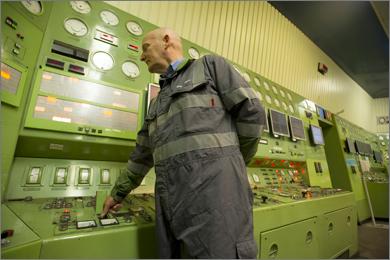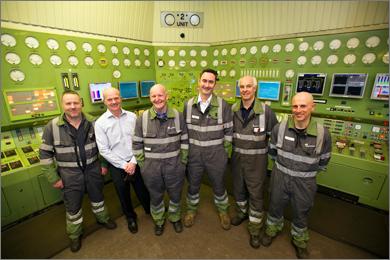- Site already has a planning consent for a 1,000MW CCGT gas-fired power station
- ScottishPower calls for clarity on a capacity mechanism for thermal generation in the Energy Bill
- Cockenzie is one of several core GB Power Stations set to close in 2013 that are opted out of the EU’s Large Combustion Plant Directive
On average, Cockenzie powered approximately 1 million homes every year during its operational lifetime.
Cockenzie Power Station in East Lothian shut down its four turbines for the very last time today (Friday 15th March), as the 45 year old coal-fired power station generated its final contribution of electricity for Britain’s national grid. At approximately 8.30am, ScottishPower engineers ceased generation at Cockenzie, as it used the last of its permitted running hours. Each of the station’s two stacks were granted 20,000 hours of operation when it was opted out of the EU’s Large Combustion Plant Directive (LCPD) in 2008.
 The closure is part of a pre-agreed decommissioning programme with National Grid and the station is closing on time and as forecasted.
The closure is part of a pre-agreed decommissioning programme with National Grid and the station is closing on time and as forecasted.
In 2011 ScottishPower received planning permission from The Scottish Government for a 1000MW gas-fired Combined Cycle Gas Turbine (CCGT) power station to be located on the existing site at Cockenzie. The company is continuing to evaluate options for the development of the site, and has recently called for clarity on a capacity mechanism for thermal generation as part of the Energy Bill.
Around 100 members of staff are currently employed at the station, and following more than 12 months of engagement with staff and trade unions, many will now be moving into other power stations or business areas with ScottishPower, whilst some others have opted to take retirement or a severance package, all of which has been agreed as part of a voluntary process.
Neil Clitheroe, ScottishPower’s CEO of Energy Retail and Generation, said: “It is the end of an era for ScottishPower and for the people at Cockenzie Power Station, who I would like to thank for all of their hard work and commitment over the last 45 years. Every man and woman who has ever been connected with the power station has played an important role in helping to keep the lights on in Scotland and across Great Britain. When Cockenzie became operational in 1967, the world was a very different place, but the station was designed to such a high standard that it played a pivotal role in maintaining the security of electricity supplies in Britain for more than four decades.
“Cockenzie is one of a number of core power stations in Britain that are due to cease operations this year, and it is vitally important that we receive clarity from the Energy Bill to allow companies like ours to be confident in making investment decisions for a new generation of replacement gas power stations. We have planning consent for a new gas-fired station here in Cockenzie, but like many other companies, we are unable to commit to new investment in gas generation until we fully understand how the market will work in the future.”
Originally operational in the summer of 1967, Cockenzie was officially opened on the 24th May 1968 by the Secretary of State for Scotland, The Rt. Hon. William Ross. The Power Station generated more than 150 Terawatt Hours (TWh) of electricity in its lifetime, enough to power the average annual electricity needs of more than 1 million homes every year during its 45 years of operation*. In total, it is estimated that more than 10,000 people have been employed at Cockenzie, during construction and operation, with many thousands of other jobs supported in the wider supply chain and local area.
When Cockenzie opened in 1967, it was the largest power station in Scotland and Britain was still 2 years away from natural gas being used in electricity generation. Coal accounted for approximately 72% of the fuel input used for electricity generation in Britain, compared to approximately 34% in 2011**.
 In an average year the station would receive approximately 800 train loads of coal, meaning that up to 36,000 freight trains stopped at Cockenzie’s coal handling plant to make deliveries over the lifetime of the station. The last delivery took place at 3pm on Saturday 9th March.
In an average year the station would receive approximately 800 train loads of coal, meaning that up to 36,000 freight trains stopped at Cockenzie’s coal handling plant to make deliveries over the lifetime of the station. The last delivery took place at 3pm on Saturday 9th March.
Designed by Sir Robert Matthew (who also designed Edinburgh Airport and the Royal Commonwealth Pool), and famous for its distinctive twin chimney stacks, the station was built with a generating capacity of 1,200MW, comprising four identical units, each capable of generating 300MW. Due to strategic investment and high levels of maintenance, the station comfortably outlived its original estimates of a 25-30 year life cycle. ScottishPower announced in April 2011 that the output of the station would be halved to 550MW from April 2012 as part of its remit to manage the remaining hours
Until the end of March ScottishPower staff will still be on-site before the process of decommissioning the power station begins. All of the old plant is due to be stripped from inside the turbine hall, some of which will be recycled and put to use at other power stations in ScottishPower’s fleet. No firm timetable has been put in place for any work beyond this, but the company will keep the local community informed of any future plans at the station.
Notes to Editors:
*Based on GB average domestic electricity consumption of 3.300kWh per year.
** https://www.gov.uk/government/statistical-data-sets/historical-electricity-data-1920-to-2011
- Cockenzie Power Station occupies a 93 hectare site on the south shore of the Forth Estuary in East Lothian.
- The twin chimney stacks at Cockenzie are each 149 metres in height.
- The grounds of Cockenzie Power Station, especially its ash settling lagoons, provide a range of habitats for local wildlife, including woodland, meadows and wetlands.
- The 120-hectare ash lagoons in Musselburgh are widely recognised as one of the best places to watch birds in Scotland. In particular, specially constructed wader scrapes – shallow freshwater pools lined with clay built on a decommissioned area – have been included within the Firth of Forth Site of Special Scientific Interest (SSSI) in recognition of their value to birds.
- The Station has supported a wide variety of community events and projects in its lifetime, including the 3Harbours Arts Festival.